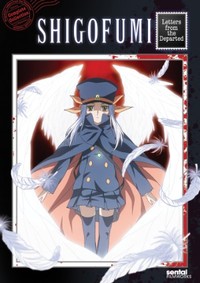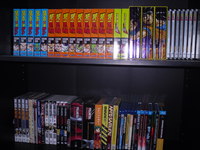Shelf Life
The Departed
by Erin Finnegan,

Birdy the Mighty: Decode part 2 DVD
Rental Shelf
Dragonball Z - Dragon Box vol. 4 DVD
Shigofumi - Letters from the Departed complete collection
Perishable
None this week
Thank God it was just a dream. (I've never even seen the DBZ live action movie.)
Without doing any math, I'm going to wager that 10% of the titles I've reviewed for Shelf Life have been from the Dragonball franchise. It's clearly starting to affect my subconscious…!
 Maybe it's just my Toriyama-related madness talking, but I'm starting to think Vegeta looks pretty hot. There's just something about his widow's peak…
Maybe it's just my Toriyama-related madness talking, but I'm starting to think Vegeta looks pretty hot. There's just something about his widow's peak…In all seriousness, this box is where the bones of the plot are picked clean by so many filler arc vultures. It reminded me of driving through Detroit in the late 1990s on highways so worn down that the steel grid of the road was showing through; you're just not supposed to see that inner structure. At the end of the last set, we were introduced to Bulma's son Trunks, who traveled back in time to stop Dr. Gero's evil androids from destroying the world. In this set, events begin to unfold in a way that Trunks doesn't remember, meaning that he has succeeded in changing the time stream.
Unfortunately, this means that the plot has to stop dead for at least one episode as the characters discuss parallel universes. Not that there's so much plot to stop at this point. For God's sake! The story is so extended that the androids have enough time to steal a truck and drive around having aimless skirmishes. There's no way this happened in the manga.
Eventually things become so convoluted that a second time machine is introduced. Note to amateur writers: if your time travel plot is so screwed up you have to start introducing multiple time machines, you're probably doing it wrong (unless you're writing for The Brak Show). But whatever, fine, I can believe the second time machine. More alarming than that, baby Trunks meets his adult self and plays with his own hair and there are no time crisis consequences whatsoever. What the hell?!
This set introduces Cell, and tells the unlikely tale of his creation. I guess I missed a few of these episodes on Cartoon Network because I didn't know Cell was genetically created from cells taken from Frieza, Goku, Piccolo, et al. There is a certain wonderful logic to this. Shonen Power Creep dictates that Goku must continue to fight ever more powerful villains. Short of a straight up clone of Goku, Cell is the next logical opponent.
And that's fine, that's very creative of Toriyama. However, I couldn't suspend my disbelief when Cell stopped fighting Trunks in order to declare that he's going to hold another World Martial Arts Tournament. Really? Really!? It's as if Cell is acknowledging that Dragonball was the best back during season four of the original series, and why can't we go back to those days? It's totally ridiculous. But then again, I can't imagine anyone, including me, watching Dragonball because it's so plausible.
In case you're confused by the crazy parallel time stream, it's all explained in a handy chart included in the lovely hardcover book that comes with this set. I don't think I've mentioned it in my Dragon Box reviews up to this point, but these discs default to the Japanese audio, which is a rarity among dubbed releases. Also, the discs are arranged in the boxes from right to left, Japanese style, so I accidentally started watching them out of order.[TOP]
After 41 episodes of this cartoon equivalent of the Muscle Musical, I was ready for a series without any muscles at all.
 I rented this since I'd never heard of it and Sentai Filmworks re-released a set in 2010. Shigofumi is a little dark and a little thoughtful. It reminded me a bit of Boogiepop Phantom, but whereas Boogiepop is Shelf Worthy enough to warrant a second viewing, Shigofumi is not. But it's not a bad series by any means.
I rented this since I'd never heard of it and Sentai Filmworks re-released a set in 2010. Shigofumi is a little dark and a little thoughtful. It reminded me a bit of Boogiepop Phantom, but whereas Boogiepop is Shelf Worthy enough to warrant a second viewing, Shigofumi is not. But it's not a bad series by any means.Here's the plot: dead people are allowed to write a letter (or two) expressing their true feelings shortly after death. This mysterious handwritten letter is then delivered to a recipient of one's choice via a magical girl mail carrier. This series follows Fumika, one such sullen little letter carrier, and her talkative magic staff (called an Aaron) as they deliver letters to unlucky and often unwilling recipients. It's a little like getting served.
The action doesn't follow Fumika as much as it does the letter recipients (deliverees?). With this type of framing device, it can be hard to get attached to one-episode-only characters, sort of like in Golgo 13. As if the show anticipated this problem, many of the recipients in Fumika's delivery zone have things in common, so characters are connected across episodes in a way that feels pleasantly coincidental (like in a more casual Tokyo Godfathers sort of way). After the first third of the series, we learn a little more about Fumika's personal story. Eventually we meet Kanaka, who is another much more talkative magic postal worker, as well as a small set of persistent characters who carry us through to the end of this short series.
Structurally, it's interesting enough. My problem with Shigofumi is the sudden shifts in tone. The first half of the series deals with ripped-from-the-headlines social problems like teen suicide and school shootings (or more specifically school hostage crises). Then we jump from ABC After School Special territory into anime-land. Damnit if there's not a hot springs episode (even the talking staffs get to bathe). Besides, Fumika looks like a magical girl! Every time she shows up it's a little weird, as if the "real" tooth fairy popped up in the original Degrassi Junior High . The episodes dealing with Fumika's past seem like something that only happen in manga or light novels. Without mentioning spoilers, her father is an larger-than-life crazy bishonen guy.
Everything comes together in the end in a satisfying way, but because all the loose ends are tied up, and all our questions are answered, I don't think this is worth watching twice. It's like a jigsaw puzzle. Once you've solved it, are you going to bust it up and put it back the box? Or is it worth gluing together and framing? You know that kind of cheesy crap just collects dust and ends up in garage sales. Shigofumi is just going to collect dust on your shelf.
There is no dub, but there are some extras. One of the two discs includes a series of audio-only shorts set over still images. It seemed like it might be from a drama CD or something.[TOP]
After watching a gloomy protagonist like Fumika I was more than happy to watch the energetic, super-genki Birdy the Mighty again.
 After my positive review of part one of Birdy, several forum readers said that part two was even better. You guys were totally right, the second half is even better.
After my positive review of part one of Birdy, several forum readers said that part two was even better. You guys were totally right, the second half is even better.Part Two seems to acknowledge that Tsutomu was the weakest link on this show. He's hardly in Part Two at all. Instead, we focus on Birdy and once in a while Tsutomu pops up to ask a question about something. It's as if the characters have grown so accustomed to sharing the same body that the show is able to drop the Man with Two Brains premise almost entirely.
Here we follow Birdy's would-be romance with a (get ready for it) childhood friend. Love Hina has sickened me on the childhood friend premise, but fortunately, Birdy's friend Nataru (also from the Altair system) is a great character deeply involved with the plot and not just some checklist archetype.
Years ago on Birdy's home planet, when she and Nataru were kids, a government building called the Central Tower was bombed by a terrorist group of human-like Altans. Nataru, being an Altan, faced discrimination and lived in an Altan slum. He met Birdy when she saved him from some bullies (another classic anime stereotype that somehow works well here). It turns out Birdy is an Ixorian, a kind of genetic experiment government super weapon, which is where she gets her crazy strength and fighting prowess.
On present day Earth someone (or something) has been killing off an escaped band of alien terrorists one member at a time. Birdy is tasked with their capture before they get wiped out. What develops is a strange kind of multi-directional conflict where, after a few very brutal murders, the terrorists start to seem more sympathetic. The added complexity makes for a terrific prime-time action premise.
There's a ton of great stuff in this show. Themes about terrorism and refugees and mistrust of the government are all neatly woven into a fun sci-fi plot. It's reminiscent of Ghost in the Shell: Stand Alone Complex 2nd GIG, except where GitS can be loftily philosophical, Birdy manages to stay accessible with less talk and more fight scenes.
A lot of effort has gone into animating this show, and specifically into animating Birdy herself. Good animation takes weight, gravity, anticipation and follow-through seriously. Birdy moves fast, but all of her actions have great follow-through, and we get a wonderful sense of how her personal physics work as she leaps from building to building. In a climactic battle towards the end of the series, Birdy fights a foe at an inhuman speed, and the show uses animated backgrounds and a scribble-y look to portray movement on the very edge of the eye's perception.
Plus the dub is fantastic. That said, I ought to mention that while the dub script differs from the subs in a way that sounds very natural, occasionally the lines are altered so much that the original meaning is changed. For example, in a scene towards the end of the series, Tsutomu's classmates are giving a report on a refugee camp in Roppongi. In the sub script, Natsumi says that refugees have been reduced to the level of children, depending on their parents. The dub script substitutes the infantilization commentary with more generic statements about loving thy neighbor. The script consistently features one or two major line changes of this sort per episode. It doesn't exactly change the plot… but it's interesting to note the difference between scripts.
A one-episode OVA that takes place outside of the main continuity is included at the end of the set. It doesn't add much to the show.
I'd recommend this series to anyone, especially science fiction fans.[TOP]
By the way, Birdy could totally win Ninja Warrior, but that would be cheating since she's an alien.
I learned about the Muscle Musical watching Ninja Warrior in Japan. (Unlike in America they show all the contestants in one really long program with very few commercials twice a year.) Two types of contestants blew through the first obstacle course, Muscle Musical actors and Americans. The Americans were all, like, a foot taller than the Japanese contestants! It seemed like cheating!
I'm not aiming to compete on Ninja Warrior anytime soon, instead my muscles are atrophying while I watch part two of Oh! Edo Rocket. See you next week!

In honor of the ever-continuing reviews of Dragon Ball Z, this week's shelves are from DBZ fan Roy, who's looking forward to the next few months:
"not much but hope to clean up this coming march with alot of releases from Funimation"

Thanks!
Want to show off your stuff? Send your jpgs to shelflife at animenewsnetwork dot com. Thanks!
discuss this in the forum (40 posts) |